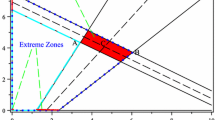Abstract
In this article, we present two different analytical methods based on embedding technique and bipolar fuzzy center to solve bipolar fuzzy linear system (BFLS) of equations. In the first method, to solve BFLS of equations, we replace BFLS of equations by a pair of positive\((*)\) and negative\((\bullet )\) two \(n \times n\) crisp linear systems. We provide the necessary and sufficient conditions for the solution of BFLS of equations. In the second method, we use the graphical technique and apply bipolar fuzzy center to draw a graph at some specific end points to solve the BFLS of equations. Further, we develop a technique to solve the fully bipolar fuzzy linear system of equations. We present solutions of some numerical examples to show the effectiveness of the proposed techniques.













Similar content being viewed by others
References
Abbasbandy S, Alavi M (2005) A method for solving fuzzy linear systems. Fuzzy Sets Syst 2(2):37–43
Abbasbandy S, Jafarian A (2006) Steepest descent method for system of fuzzy linear equations. Appl Math Comput 175(1):823–833
Akram M, Arshad M (2019) A novel trapezoidal bipolar fuzzy TOPSIS method for group decision-making. Group Decis Negot 28(3):565–584
Akram M, Muhammad G, Koam AN, Hussain N (2019a) Iterative methods for solving a system of linear equations in a bipolar fuzzy environment. Mathematics 7(8):728
Akram M, Muhammad G, Allahviranloo T (2019b) Iterative methods for solving a system of linear equations in a bipolar fuzzy environment. Mathematics 7(8):728
Akram M, Muhammad G, Hussian N (2019c) Bipolar fuzzy system of linear equations with polynomial parametric form. J Intell Fuzzy Syst 37(6):8275–8287
Akram M, Saleem D, Allahviranloo T (2019d) Linear system of equations in m-polar fuzzy environment. J Intell Fuzzy Syst 37(6):8251–8266
Akram M, Muhammad G, Allahviranloo T (2019e) Bipolar fuzzy linear system of equations. Comput Appl Math 38(2):69
Allahviranloo T (2004) Numerical methods for fuzzy system of linear equations. Appl Math Comput 155(2):493–502
Allahviranloo T (2005a) Successive over relaxation iterative method for fuzzy system of linear equations. Appl Math Comput 162(1):189–196
Allahviranloo T (2005b) The Adomian decomposition method for fuzzy system of linear equations. Appl Math Comput 163(2):553–563
Allahviranloo T (2019) Uncertain information and linear systems, studies in systems, decision and control. Springer, Berlin, p 254
Dubois D, Prade H (1978) Operations on fuzzy numbers. Int J Syst Sci 9:613–626
Friedman M, Ming MMa, Kandel A (1998) Fuzzy linear systems. Fuzzy Sets Syst 96:201–209
Minc H (1988) Nonnegative matrices. Wiley, New York
Ming M, Friedman M, Kandel A (1999) A new fuzzy arithmetic. Fuzzy Sets Syst 108(1):83–90
Senthilkumar P, Rajendran G (2009) Solution of fuzzy linear systems by using fuzzy centre. Appl Math Sci 3(49):2411–2419
Suparna D, Chakraverty S (2011) Numerical solution of interval and fuzzy system of linear equations. Doctoral dissertation
Zadeh LA (1965) Fuzzy sets. Inf Control 8(3):338–353
Zadeh LA (1975) The concept of a linguistic and application to approximate reasoning-I. Inf Sci 8:199–249
Zhang WR (1994) Bipolar fuzzy sets and relations: a computational framework forcognitive modeling and multiagent decision analysis. In: Proceedings of IEEE conference, pp 305–309
Zhang WR (1998) YinYang Bipolar fuzzy sets. In: IEEE world congress on fuzzy systems proceedings. Computational Intelligence, pp 835–840
Author information
Authors and Affiliations
Corresponding author
Ethics declarations
Conflict of interest
The authors declare that they have no conflict of interest regarding the publication of the research article.
Additional information
Communicated by Leonardo Tomazeli Duarte.
Publisher's Note
Springer Nature remains neutral with regard to jurisdictional claims in published maps and institutional affiliations.
Rights and permissions
About this article
Cite this article
Akram, M., Ali, M. & Allahviranloo, T. Certain methods to solve bipolar fuzzy linear system of equations. Comp. Appl. Math. 39, 213 (2020). https://doi.org/10.1007/s40314-020-01256-x
Received:
Revised:
Accepted:
Published:
DOI: https://doi.org/10.1007/s40314-020-01256-x



